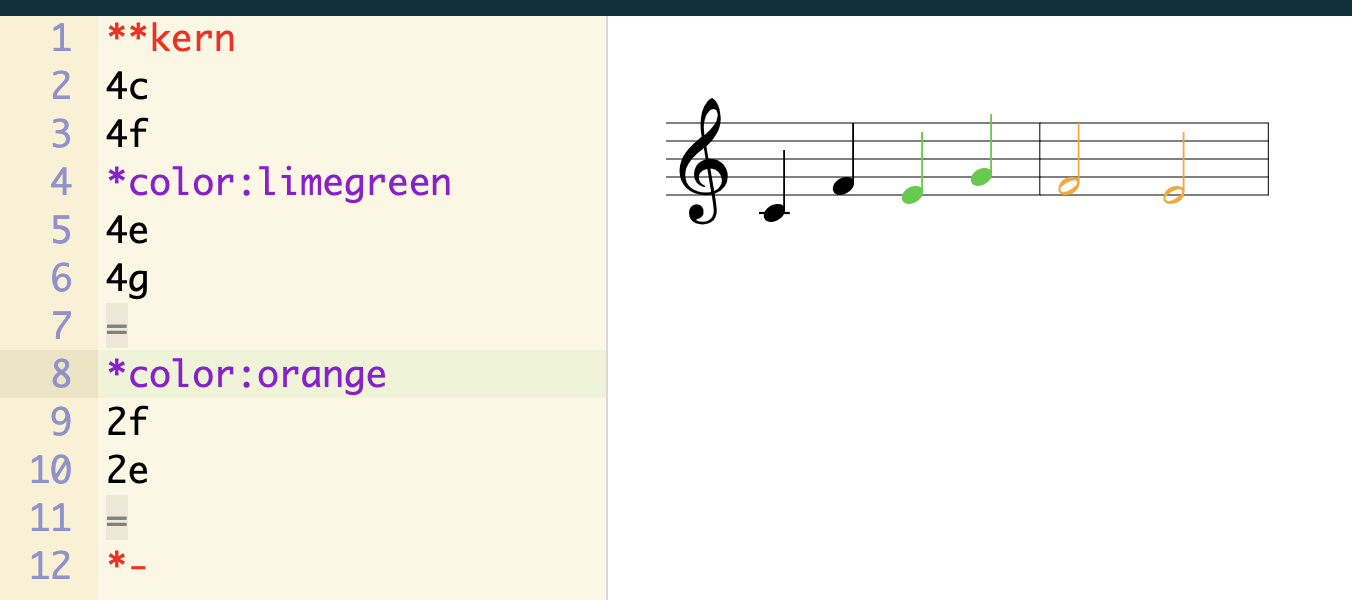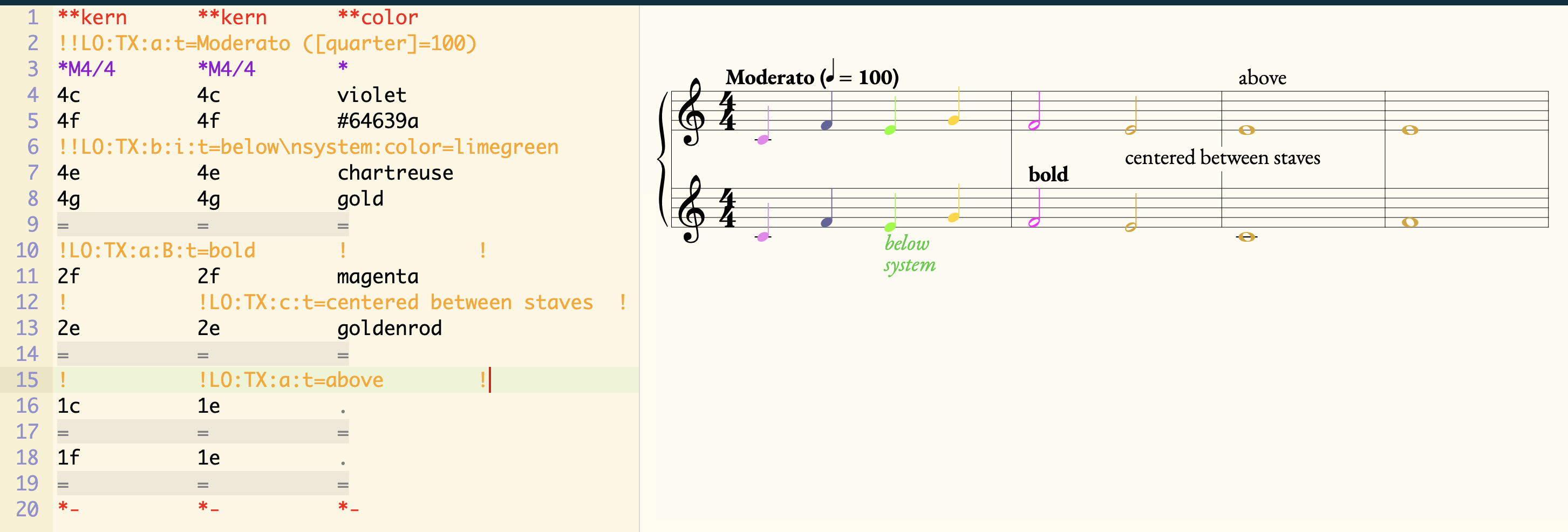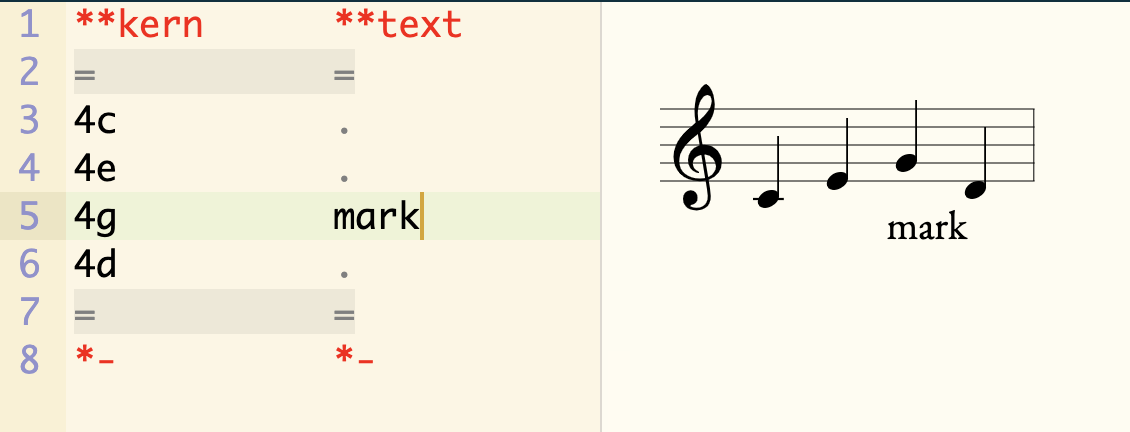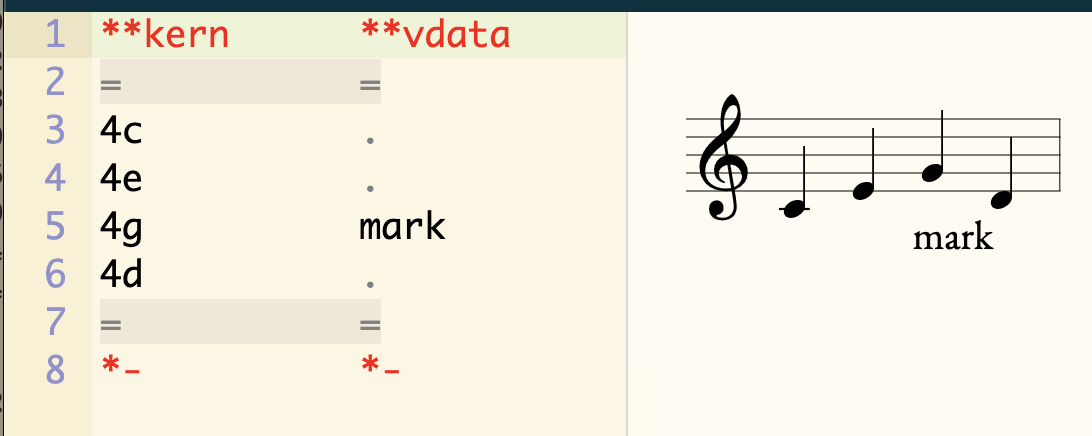coloring notes with humdrum/verovio
38 views
Skip to first unread message
Malcolm Sailor
Feb 8, 2022, 11:28:17 AM2/8/22
to starstarhug
I'm wondering if it is possible with humdrum and verovio to color specific notes specific colors? (E.g., have some notes show up as green.) Or alternately/in addition, to annotate them? (I.e., have a text label show up below/above a given note.)
Thanks so much!
Craig Sapp
Feb 8, 2022, 11:43:23 AM2/8/22
to stars...@googlegroups.com
Hi Malcolm, et al.,
There are a few ways to do what you want, which are illustrated below. These work in VHV, Humdrum Notation Plugin (https://plugin.humdrum.org), and plain verovio -- since they are implemented in the Humdrum import to verovio.
Verovio can be run from the command-line for batch-processing of Humdrum into SVG images. To download and compile:
git clone https://github.com/rism-digital/verovio
cd verovio/tools
git checkout develop-humdrum # (for the latest version of the Humdrum converter)
./.configure
make
make install
Then to compile a Humdrum file into notation:
verovio file.krn
this will create file.svg containing the graphical music notation.
There are lots of options to verovio (see https://plugin.humdrum.org/options with verovio options colored purple). Or type "verovio" as a command without arguments to the the list on the command line. Useful ones for short examples:
--adjust-page-height == make the SVG the height of the music, not of the page height (i.e., shrink the page to the height of the music.
--adjust-page-width == the same for the width of the music.
--page-height # == set the height of the page, # is roughly 1/10 mm, default 2970
--page-width # == set the width of the page, default for # is 2100
--scale (or -s) == set the scale of the music (meaning the size) Units are percentages where I typically use 40, and default is 100.
-o filename == output to a different filename than automatically given. Using "-o -" will output to standard output.
example of using some of the commands (which can go before or after the filename):
verovio file.krn --adjust-page-height --scale 55 -o image.svg
Here are the three main ways of coloring notes:
(1) Marking individual notes with color:

There are a limited number of user-signifiers (characters that do not have predefined meanings in Humdrum. Some others are |, +, i, j.
(2) Color interpretation: useful to set color of all notes to one specific color afterwards:

(3) Color spine: An independent spine for color can be used to color all **kern spines to its left. This is useful for harmonic colorings:

(you can have multiple **color lines, and each one will apply to all **kern spines
There are also more advanced ways of colorings notes that you are probably not interested in (they are outside of verovio and more for post-processing of the SVG image on a webpage):

For text labels, there are three possibilities:
(1) A staff or system label (staff labels have a single !, and system have two !!) They can be attached to notes by immediately preceding the note (or rest), as well as time signatures by coming just before a time signature:

(2) as lyrics:

(2b) as "verse-like data" which is not much different (just officially marked as not being real lyrics):

Text can only be applied to note attacks (not rests).
(3) as chord-like data:

cdata can occur independent of note attacks (the **recip spine allows placing at second 8th of quarter note in above example). cdata can currently only be placed above the staff, I believe.
-=+Craig
On Tue, 8 Feb 2022 at 06:58, Malcolm Sailor <malcolm...@gmail.com> wrote:
PS I realize I wrote "vhv" which I believe refers to your online humdrum viewer? That is not necessarily important. What I'd really like to be able to do is produce annotated musical examples from a shell script.On Tue, Feb 8, 2022 at 9:54 AM Malcolm Sailor <malcolm...@gmail.com> wrote:Hi CraigHope you are well.I had the following question and I was wondering if you could help me:Is it possible with humdrum and vhv to color specific notes specific colors? (E.g., have some notes show up as green.) Or alternately/in addition, to annotate them? (I.e., have a text label show up below/above a given note.)Many thanks!Malcolm
Malcolm Sailor
Sep 28, 2023, 10:46:49 AM9/28/23
to stars...@googlegroups.com
Dear Craig,
A follow-up question:
If we are using system or staff labels, like `!!LO:TX:b:i:t=below\nsystem:color=limegreen`, is there any way to apply different colors to different segments of the text? E.g., in this case, set "below" in one color and "system" in another?
Thanks,
Malcolm
--
--
This is a message is from the **HUG newgroup.
To post to this group, send email to stars...@googlegroups.com
To unsubscribe from this group, send email to
starstarhug...@googlegroups.com
For more options, visit this group at
http://groups.google.com/group/starstarhug?hl=en
---
You received this message because you are subscribed to a topic in the Google Groups "starstarhug" group.
To unsubscribe from this topic, visit https://groups.google.com/d/topic/starstarhug/shZlpJ5i25M/unsubscribe.
To unsubscribe from this group and all its topics, send an email to starstarhug...@googlegroups.com.
To view this discussion on the web visit https://groups.google.com/d/msgid/starstarhug/CAPcjuFdvV%3DkWi2MjYSF89FwJG%3Dm4Rpuqjt9nuAwX5KUXFhMVOQ%40mail.gmail.com.
Craig Sapp
Sep 28, 2023, 11:42:39 AM9/28/23
to stars...@googlegroups.com
Hi Malcolm,


A finer-grained system to have multiple colors in a block of text is possible, but I haven't implemented it.
In this particular case, however, the text can be broken up into two pieces:

In addition, if you want to display system-level data underneath the system, it is possible by adding spines of data at the start of the text lines lines:

(*italic is not implemented, but should be easy to do)
Malcolm Sailor
Oct 19, 2023, 1:12:38 PM10/19/23
to stars...@googlegroups.com
Hi Craigg,
There are a limited number of user-signifiers (characters that do not have predefined meanings in Humdrum. Some others are |, +, i, j.
Is there anywhere I can get a complete list of user-signifiers? If I run out, is it possible to use bigrams of characters or anything like that?
Thanks!
Malcolm
Wolfgang Drescher
Oct 19, 2023, 3:26:19 PM10/19/23
to starstarhug
Hi Malcolm,
There are a limited number of user-signifiers (characters that do not have predefined meanings in Humdrum. Some others are |, +, i, j.Is there anywhere I can get a complete list of user-signifiers? If I run out, is it possible to use bigrams of characters or anything like that?
I use the characters N, V, Z, @, +, |, <, > that I found on https://extras.humdrum.org/man/cint/ (Module note marking). I usually reserve lowercase letters for things like editorial accidentals or similar.
I also tried using emojis (or any other unicode character) instead to not conflict with other existing reserved characters. But I've had some problems with that, so for now I'm just using the above characters.
Best,
Wolfgang
Craig Sapp
Oct 19, 2023, 11:31:05 PM10/19/23
to stars...@googlegroups.com
Hi Malcolmm,
Section 3.7 on this page also has a list of the **kern user signifiers:
https://www.humdrum.org/Humdrum/representations/kern.html#Table%20of%20Signifiers
i j l N V Z @ + | < >
In my software, bigrams have not been allowed due to the complexity of applying meaning to the signifiers (if i, j, and ij are three different signifiers, then ij, and i+j are problematic to separate). But in theory they should be allowed (and also you can use bigrams for your own purposes/software already), so I will work on that for RDF markers used in verovio/MEI conversions. I do use duplications of a specific signifer to have slightly different meanings such as doubling the terminal long signifier to make the note look like a maxima:


Section 3.7 on this page also has a list of the **kern user signifiers:
https://www.humdrum.org/Humdrum/representations/kern.html#Table%20of%20Signifiers
i j l N V Z @ + | < >
In my software, bigrams have not been allowed due to the complexity of applying meaning to the signifiers (if i, j, and ij are three different signifiers, then ij, and i+j are problematic to separate). But in theory they should be allowed (and also you can use bigrams for your own purposes/software already), so I will work on that for RDF markers used in verovio/MEI conversions. I do use duplications of a specific signifer to have slightly different meanings such as doubling the terminal long signifier to make the note look like a maxima:

In theory all UTF-8 characters which are not also UTF-7 (lower half of ASCII bytes) are also user signifiers. They were not really allowed until today:
UTF-8 as Wolfgang mentions is a good solution for nearly unlimited user signifiers.
I assume that Humdrum data is in the UTF-8 format, so any UTF-8 character other than the UTF-7 (lower half of ASCII) is a user signifier in **kern. Here is an example of coloring notes by pitch class using RDF markers:

Using UTF-8 characters works well on MacOS since the operating system uses UTF-8 natively. Windows and Linux do not, so there may be some unwanted character translations depending on editing or data processing software. I don't have problems editing UTF-8 files in Linux and MacOS using vi. Also UTF-8 is the default character set for HTML, so should also work well on the web.
-=+Craig
Malcolm Sailor
Oct 20, 2023, 8:36:37 AM10/20/23
to stars...@googlegroups.com
In theory all UTF-8 characters which are not also UTF-7 (lower half of ASCII bytes) are also user signifiers. They were not really allowed until today:UTF-8 as Wolfgang mentions is a good solution for nearly unlimited user signifiers.
Wow, thanks, that's great!
Malcolm
Malcolm Sailor
Oct 20, 2023, 10:49:45 AM10/20/23
to stars...@googlegroups.com
A follow up:
I've tried using UTF-8 characters as user signifiers but unfortunately, these characters seem to get removed (and sometimes replaced with newlines) by humdrum-tools that are an important part of my workflow. For example, when I put the following in a file:
```
**kern
=
4A€
4F#…
*-
```
=
4A€
4F#…
*-
```
(The tokens have characters 128 and 133 respectively at the ends. 133 is non-printing for me in gmail.)
And then run `timebase -t 8 file.krn`, I get the following output:
```
**kern
*tb8
=
4A
.
4F#
.
*-
*tb8
=
4A
.
4F#
.
*-
```
Any way of allowing non-ASCII characters with humdrum-tools?
Thanks!
Malcolm
Craig Sapp
Oct 20, 2023, 6:46:23 PM10/20/23
to stars...@googlegroups.com
Hi Malcolm,

When I use timebase in MacOS terminal, I am not having any problems with UTF-8 characters:

Presumably you are doing this in Windows (with Cygwin?)? Or otherwise you can say what OS and environment you are using.
If you are trying to display the contents of the file in a non UTF-8 terminal or software, then it is unlikely that the file will display correctly unless there is an automatic detection and conversion of UTF-8 into whatever font system is being used. So it is not necessarily that timebase is not able to handle UTF-8, but rather the display cannot handle UTF-8. Timebase in theory should not have any problems with UTF-8 characters. If you do certain regular expressions, UTF-8 may have problems because UTF-8 characters can have up to 5 bytes for one character, so "." in regular expressions in non-UTF-8 systems will match to one byte and not to one UTF-8 "character". Timebase does not need to deal with such. characters, and should be echoed in the output without alteration.
One way to test is to output the results to a *.txt file and then open the file:
timebase -t 8 file.krn > file.txt
And then open file.txt in a web browser to examine its contents.
-=+Craig
Malcolm Sailor
Oct 20, 2023, 10:53:45 PM10/20/23
to stars...@googlegroups.com
Thanks for your help, Craig. I am also using a UTF-8 terminal in MacOS.
The problem turns out to be that the characters I was using are non-printing (and one of them is interpreted as a line break). (I was just generating them programmatically starting from character code 128.) But for some reason that I don't understand they *were* printing in my code editor (VS Code). Since I could see them there, I was expecting them to print in the terminal.
--
--
This is a message is from the **HUG newgroup.
To post to this group, send email to stars...@googlegroups.com
To unsubscribe from this group, send email to
starstarhug...@googlegroups.com
For more options, visit this group at
http://groups.google.com/group/starstarhug?hl=en
---
You received this message because you are subscribed to a topic in the Google Groups "starstarhug" group.
To unsubscribe from this topic, visit https://groups.google.com/d/topic/starstarhug/shZlpJ5i25M/unsubscribe.
To unsubscribe from this group and all its topics, send an email to starstarhug...@googlegroups.com.
To view this discussion on the web visit https://groups.google.com/d/msgid/starstarhug/CAPcjuFeN9mi6z9nED9TyGTRPiUrd%3Dp7NKN4o%3DOOs0b44Fm6fmw%40mail.gmail.com.
Craig Sapp
Oct 21, 2023, 3:02:00 AM10/21/23
to stars...@googlegroups.com
Hi Malcolm,

If you use 128 (hex 80) as a single character, note that that is not UTF-8 (what you are probably thinking of is called a Unicode character). To get Unicode character 0x80 (decimal 128), you need to use the two bytes 0xC2 and 0x80, since UTF-8 is a variable byte length character encoding system for Unicode.
Here is a chart that shows how the bits are stored for the Unicode character in UTF-8 from the wikipedia entry for UTF-8:

For bytes 0 to 127 (UTF-7), there is a single byte (first line in the table). Starting with 128 (0x80) Two bytes are needed, with the first byte starting with the bits 110 then the top 5 bits of the actual number, then the second byte starting with the bits 10, and then the last 6 bits of the number. For example, 128 are the bits:
10000000
Splitting that into 6 at the bottom and 5 top bits (adding leading zeros):
00010 000000
and adding the required packing bits:
1100010 10000000
converting to hex:
C2 80
So hex bytes "C2 80" is UTF-8 for Unicode character 128. (which is a padding character that you should probably avoid).
Probably starting with the emoji character range you will have a longer sequence of printable characters. Here is a list starting with Unicode character number 128512 (hex 1F600, which is UTF-8 hex bytes F0 9F 90 80):
| Emoji | UNICODE Value | UTF-8 Hex Byte Codes |
|---|---|---|
| 😀 Grinning Face | U+1F600 | F0 9F 98 80 |
| 😁 Beaming Face with Smiling Eyes | U+1F601 | F0 9F 98 81 |
| 😂 Face with Tears of Joy | U+1F602 | F0 9F 98 82 |
| 😃 Grinning Face with Big Eyes | U+1F603 | F0 9F 98 83 |
| 😄 Grinning Face with Smiling Eyes | U+1F604 | F0 9F 98 84 |
| 😅 Grinning Face with Sweat | U+1F605 | F0 9F 98 85 |
| 😆 Grinning Squinting Face | U+1F606 | F0 9F 98 86 |
| 😇 Smiling Face with Halo | U+1F607 | F0 9F 98 87 |
| 😈 Smiling Face with Horns | U+1F608 | F0 9F 98 88 |
| 😉 Winking Face | U+1F609 | F0 9F 98 89 |
| 😊 Smiling Face with Smiling Eyes | U+1F60A | F0 9F 98 8A |
| 😋 Face Savoring Food | U+1F60B | F0 9F 98 8B |
| 😌 Relieved Face | U+1F60C | F0 9F 98 8C |
| 😍 Heart Eyes | U+1F60D | F0 9F 98 8D |
| 😎 Smiling Face with Sunglasses | U+1F60E | F0 9F 98 8E |
| 😏 Smirking Face | U+1F60F | F0 9F 98 8F |
| 😐 Neutral Face | U+1F610 | F0 9F 98 90 |
| 😑 Expressionless Face | U+1F611 | F0 9F 98 91 |
| 😒 Unamused Face | U+1F612 | F0 9F 98 92 |
| 😓 Face with Cold Sweat | U+1F613 | F0 9F 98 93 |
| 😔 Pensive Face | U+1F614 | F0 9F 98 94 |
| 😕 Confused Face | U+1F615 | F0 9F 98 95 |
| 😖 Confounded Face | U+1F616 | F0 9F 98 96 |
| 😗 Kissing Face | U+1F617 | F0 9F 98 97 |
| 😘 Face Blowing a Kiss | U+1F618 | F0 9F 98 98 |
| 😙 Kissing Face with Smiling Eyes | U+1F619 | F0 9F 98 99 |
| 😚 Kissing Face with Closed Eyes | U+1F61A | F0 9F 98 9A |
| 😛 Face with Tongue | U+1F61B | F0 9F 98 9B |
| 😜 Winking Face with Tongue | U+1F61C | F0 9F 98 9C |
| 😝 Squinting Face with Tongue | U+1F61D | F0 9F 98 9D |
| 😞 Disappointed Face | U+1F61E | F0 9F 98 9E |
| 😟 Worried Face | U+1F61F | F0 9F 98 9F |
| 😠 Angry Face | U+1F620 | F0 9F 98 A0 |
| 😡 Pouting Face | U+1F621 | F0 9F 98 A1 |
| 😢 Crying Face | U+1F622 | F0 9F 98 A2 |
| 😣 Persevering Face | U+1F623 | F0 9F 98 A3 |
| 😤 Face with Steam From Nose | U+1F624 | F0 9F 98 A4 |
| 😥 Sad but Relieved Face | U+1F625 | F0 9F 98 A5 |
| 😦 Frowning Face with Open Mouth | U+1F626 | F0 9F 98 A6 |
| 😧 Anguished Face | U+1F627 | F0 9F 98 A7 |
| 😨 Fearful Face | U+1F628 | F0 9F 98 A8 |
| 😩 Weary Face | U+1F629 | F0 9F 98 A9 |
| 😪 Sleeping Face | U+1F62A | F0 9F 98 AA |
| 😫 Tired Face | U+1F62B | F0 9F 98 8B |
| 😬 Grimacing Face | U+1F62C | F0 9F 98 AC |
| 😭 Loudly Crying Face | U+1F62D | F0 9F 98 A5 |
| 😮 Face with Open Mouth | U+1F62E | F0 9F 98 AE |
| 😯 Hushed Face | U+1F62F | F0 9F 98 AF |
| 😰 Anxious Face with Sweat | U+1F630 | F0 9F 98 B0 |
| 😱 Face Screaming in Fear | U+1F631 | F0 9F 98 B1 |
| 😲 Astonished Face | U+1F632 | F0 9F 98 B2 |
| 😳 Flushed Face | U+1F633 | F0 9F 98 B3 |
| 😴 Sleeping Face | U+1F634 | F0 9F 98 B4 |
| 😵 Dizzy Face | U+1F635 | F0 9F 98 B5 |
| 😶 Face Without Mouth | U+1F636 | F0 9F 98 B6 |
| 😷 Face with Medical Mask | U+1F637 | F0 9F 98 B7 |
| 😸 Grinning Cat with Smiling Eyes | U+1F638 | F0 9F 98 B8 |
| 😹 Cat with Tears of Joy | U+1F639 | F0 9F 98 B9 |
| 😺 Smiling Cat with Open Mouth | U+1F63A | F0 9F 98 BA |
| 😻 Smiling Cat with Heart-Eyes | U+1F63B | F0 9F 98 BB |
| 😼 Cat with Wry Smile | U+1F63C | F0 9F 98 BC |
| 😽 Kissing Cat | U+1F63D | F0 9F 98 BD |
| 😾 Pouting Cat | U+1F63E | F0 9F 98 BE |
| 😿 Crying Cat | U+1F63F | F0 9F 98 BF |
| 🙀 Weary Cat | U+1F640 | F0 9F 99 80 |
| 🙁 Slightly Frowning Face | U+1F641 | F0 9F 99 81 |
| 🙃 Upside-Down Face | U+1F642 | F0 9F 99 83 |
| 🙄 Face with Rolling Eyes | U+1F643 | F0 9F 99 84 |
| 🤐 Zipper-Mouth Face | U+1F644 | F0 9F A4 90 |
| 🤑 Money-Mouth Face | U+1F645 | F0 9F A4 91 |
| 🤒 Face with Thermometer | U+1F646 | F0 9F A4 92 |
| 🤓 Nerd Face | U+1F647 | F0 9F A4 93 |
| 🤔 Thinking Face | U+1F648 | F0 9F A4 94 |
| 🤕 Face with Head-Bandage | U+1F649 | F0 9F A4 95 |
| 🤖 Robot Face | U+1F64A | F0 9F A4 96 |
| 🤗 Hugging Face | U+1F64B | F0 9F A4 97 |
| 🤘 Sign of the Horns | U+1F64C | F0 9F A4 98 |
| 🤙 Call Me Hand | U+1F64D | F0 9F A4 99 |
-=+Craig
Malcolm Sailor
Oct 21, 2023, 9:11:28 AM10/21/23
to stars...@googlegroups.com
Hi Craig,
Thanks for the encoding details. I was using Python's `chr()` function to get from a code point to a character, which gives a unicode string (which is encoded to UTF-8 by default when writing to a file). E.g.,
```
>>> chr(128).encode() # utf-8 by default
b'\xc2\x80'
```
So the issue wasn't that the code points weren't being encoded correctly but rather that they were appearing inconsistently between my terminal and my code editor. I agree that it's clearly better to use printing characters like the emojis you give.
Thanks again!
--
--
This is a message is from the **HUG newgroup.
To post to this group, send email to stars...@googlegroups.com
To unsubscribe from this group, send email to
starstarhug...@googlegroups.com
For more options, visit this group at
http://groups.google.com/group/starstarhug?hl=en
---
You received this message because you are subscribed to a topic in the Google Groups "starstarhug" group.
To unsubscribe from this topic, visit https://groups.google.com/d/topic/starstarhug/shZlpJ5i25M/unsubscribe.
To unsubscribe from this group and all its topics, send an email to starstarhug...@googlegroups.com.
To view this discussion on the web visit https://groups.google.com/d/msgid/starstarhug/CAPcjuFc9DeUiGkAkteYoExxbgm1Q0qgsvcEmqXxjbv-PZtU%2BCQ%40mail.gmail.com.
Reply all
Reply to author
Forward
0 new messages
